Assessment of Greenhouse Gas Emissions into the Atmosphere from the Northern Peatlands Using the Wetland-DNDC Simulation Model: A Case Study of the Great Vasyugan Mire, Western Siberia
Abstract
:1. Introduction
2. Materials and Methods
2.1. Study Area
2.2. Sampling Design
2.3. Model Wetland-DNDC
2.4. Climate
2.5. Hydrology
2.6. Vegetation
2.7. Peat Deposit
2.8. Model Input Values
2.9. Assessment of Modelling Performance
3. Results
Modelled Outputs
4. Discussion
Sensitivity Assessment
5. Conclusions
Supplementary Materials
Author Contributions
Funding
Institutional Review Board Statement
Informed Consent Statement
Data Availability Statement
Conflicts of Interest
Abbreviations
| GVM | Great Vasyugan Mire |
| NEE | net ecosystem exchange |
| NEP | net ecosystem production |
| NPP | net primary production |
| GPP | gross primary production |
| GrossPsn | gross photosynthesis of ground vegetation (groundcover) |
| RM | microbial respiration |
| RA | autotrophic respiration |
| RA + RM | ecosystem respiration (autotrophic and soil) with a positive sign indicating the direction of flux from the ecosystem to the atmosphere |
| FAR | photosynthetically active radiation |
| RA + RM | ecosystem respiration (autotrophic and soil) with a positive sign indicating the direction of flux from the ecosystem to the atmosphere |
| GrossPsn | gross photosynthesis of ground vegetation |
| WTL | groundwater level |
| Amax | maximum photosynthetic rate |
References
- Yan, L.; Zhang, X.; Wu, H.; Kang, E.; Li, Y.; Wang, J.; Yan, Z.; Zhang, K.; Kang, X. Disproportionate Changes in the CH4 Emissions of Six Water Table Levels in an Alpine Peatland. Atmosphere 2020, 11, 1165. [Google Scholar] [CrossRef]
- Parish, F.; Sirin, A.; Charman, D.; Joosten, H.; Minayeva, T.; Silvius, M.; Stringer, L. (Eds.) Assessment on Peatlands, Biodiversity and Climate Change; Main Report; Global Environment Centre, Kuala Lumpur and Wetlands International: Wageningen, Netherlands, 2008; 179p. [Google Scholar]
- Eswaran, H.E.; Van den Berg, P.R.; Kimble, J. Global soil carbon resources. In Soils and Global Change; Lal, R., Kimble, J., Levine, E., Stewart, B.A., Eds.; CRC Press: Boca Raton, FL, USA, 1995; pp. 27–43. [Google Scholar]
- Harenda, K.M.; Lamentowicz, M.; Samson, M.; Chojnicki, B.H. The Role of Peatlands and Their Carbon Storage Function in the Context of Climate Change. In Interdisciplinary Approaches for Sustainable Development Goals; Springer: Cham, Switzerland, 2017; pp. 169–187. [Google Scholar] [CrossRef]
- Charman, D.J.; Beilman, D.W.; Blaauw, M.; Booth, R.K.; Brewer, S.; Chambers, F.M.; Christen, J.A.; Gallego-Sala, A.; Harrison, S.P.; Hughes, P.D.M.; et al. Climate-related changes in peatland carbon accumulation during the last millennium. Biogeosciences 2013, 10, 929–944. [Google Scholar] [CrossRef] [Green Version]
- Zemtsov, A.A. (Ed.) Bogs of Western Siberia—Their Role in the Biosphere; TSU, SibNIIT: Tomsk, Russia, 1998; 72p. (In Russian) [Google Scholar]
- Resources of Surface Waters of the USSR. Altai and Western Siberia; Middle Ob; Gidrometeoizdat: Leningrad, Russia, 1972; Volume 15, 408p. (In Russian) [Google Scholar]
- Scientific Prerequisites for the Development Bogs of Western Siberia; Nauka: Moscow, Russia, 1977; 247p. (In Russian)
- Liss, O.L.; Berezina, N.A. Bogs of Western Siberia Plain, Moscow; Publishing House of Moscow State University: Moscow, Russia, 1981; 204p. (In Russian) [Google Scholar]
- Kuzmin, G.F. Bogs and Their Use; Sat. Scientific Works VNIIT: Leningrad, Russia, 1993; 139p. (In Russian) [Google Scholar]
- Kosykh, N.P.; Mironycheva-Tokareva, N.P.; Vishnyakova, E.K.; Koronatova, N.G.; Stepanova, V.A.; Kolesnychenko, L.G.; Khovalyg, A.O.; Peregon, A.M. Plant Organic Matter in Palsa and Khasyrei Type Mires: Direct Observations in West Siberian Sub-Arctic. Atmosphere 2021, 12, 1612. [Google Scholar] [CrossRef]
- O’Neill, A.; Tucker, C.; Kane, E.S. Fresh Air for the Mire-Breathing Hypothesis: Sphagnum Moss and Peat Structure Regulate the Response of CO2 Exchange to Altered Hydrology in a Northern Peatland Ecosystem. Water 2022, 14, 3239. [Google Scholar] [CrossRef]
- Li, Y.; Wan, Z.; Sun, L. Simulation of Carbon Exchange from a Permafrost Peatland in the Great Hing’an Mountains Based on CoupModel. Atmosphere 2021, 13, 44. [Google Scholar] [CrossRef]
- Valjarević, A.; Djekić, T.; Stevanović, V.; Ivanović, R.; Jandziković, B. GIS numerical and remote sensing analyses of forest changes in the Toplica region for the period of 1953–2013. Appl. Geogr. 2018, 92, 131–139. [Google Scholar] [CrossRef]
- Poeplau, C.; Schroeder, J.; Gregorich, E.; Kurganova, I. Farmers’ Perspective on Agriculture and Environmental Change in the Circumpolar North of Europe and America. Land 2019, 8, 190. [Google Scholar] [CrossRef] [Green Version]
- Shurpali, N.; Verma, S.B.; Kim, J.; Arkebauer, T.J. Carbon dioxide exchange in a peatland ecosystem. J. Geophys. Res. Earth Surf. 1995, 100, 14319–14326. [Google Scholar] [CrossRef]
- Silvola, J.J.; Alm, J.; Ahlholm, U.; Nykanen., H.; Martikainen, P.J. CO2 fluxes from peat in boreal mires under varying tem-perature and moisture conditions. J. Ecol. 1996, 84, 219–228. [Google Scholar] [CrossRef]
- Bubier, J.L.; Crill, P.M.; Moore, T.R.; Savage, K.; Varner, R.K. Seasonal patterns of controls on net ecosystem CO2 exchange in a boreal peatland complex. Global Biogeochem. Cycles 1998, 12, 703–714. [Google Scholar] [CrossRef] [Green Version]
- Berezin, A.E.; Bazanov, V.A.; Parshina, N.V. The influence of the oil and gas complex on the bogs of the Western Siberia taiga zone. Int. J. Environ. Stud. 2014, 71, 716–721. [Google Scholar] [CrossRef]
- Shevchenko, V.; Vorobyev, S.; Krickov, I.; Boev, A.; Lim, A.; Novigatsky, A.; Starodymova, D.; Pokrovsky, O. Insoluble Particles in the Snowpack of the Ob River Basin (Western Siberia) a 2800 km Submeridional Profile. Atmosphere 2020, 11, 1184. [Google Scholar] [CrossRef]
- Vasyugan Mire (Natural Conditions, Structure and Functioning); Inisheva, L.I. (Ed.) TSNTI: Tomsk, Russia, 2000; 181p. (In Russian) [Google Scholar]
- Bernatonis, V.K.; Arkhipov, V.S.; Zdvizhkov, M.A.; Preis Yu, I.; Tikhomirov, N.O. Geochemistry of plants and peat of the Great Vasyugan mire. In Great Vasyugan Mire. Current State and Development Processes; Publishing House of the Siberian Branch of the Russian Academy of Sciences: Tomsk, Russia, 2002; pp. 204–215. (In Russian) [Google Scholar]
- Kabanov, M.V. (Ed.) Study of Natural and Climatic Processes on the Territory of the Great Vasyugan Mire; Publishing House of the Siberian Branch of the Russian Academy of Sciences: Novosibirsk, Russia, 2012; 243p. (In Russian) [Google Scholar]
- Berezin, A.E.; Bazanov, V.A.; Skugarev, A.A.; Rybina, T.A.; Parshina, N.V. Landscapes of the Great Vasyugan Mire. In Peatlands of Western Siberia and the Carbon Cycle: Past and Present, Proceedings of the Fourth International Field Symposium, Novosibirsk; Tomsk, Russia, 4–17 August 2014, Publishing House: TSU, Tomsk, Russia, 2014; pp. 50–52. Available online: http://vital.lib.tsu.ru/vital/access/manager/Repository/vtls:000509240 (accessed on 10 October 2022).
- Cade, S.M.; Clemitshaw, K.C.; Molina-Herrera, S.; Grote, R.; Haas, E.; Wilkinson, M.; Morison, J.I.L.; Yamulki, S. Evaluation of LandscapeDNDC Model Predictions of CO2 and N2O Fluxes from an Oak Forest in SE England. Forests 2021, 12, 1517. [Google Scholar] [CrossRef]
- Li, C. Quantifying greenhouse gas emissions from soils: Scientific basis and modeling approach. Soil Sci. Plant Nutr. 2007, 53, 344–352. [Google Scholar] [CrossRef] [Green Version]
- Giltrap, D.L.; Li, C.; Saggar, S. DNDC: A process-based model of greenhouse gas fluxes from agricultural soils. Agric. Ecosyst. Environ. 2010, 136, 292–300. [Google Scholar] [CrossRef]
- Peltoniemi, M.; Thürig, E.; Ogle, S.; Palosuo, T.; Schrumpf, M.; Wutzler, T.; Butterbach-Bahl, K.; Chertov, O.; Komarov, A.; Mikhailov, A.; et al. Models in country scale carbon accounting of forest soils. Silva Fenn. 2007, 41, 575–602. [Google Scholar] [CrossRef] [Green Version]
- Bell, M.J.; Jones, E.; Smith, J.; Smith, P.; Yeluripati, J.; Augustin, J.; Juszczak, R.; Olejnik, J.; Sommer, M. Simulation of soil nitrogen, nitrous oxide emissions and mitigation scenarios at 3 European cropland sites using the ECOSSE model. Nutr. Cycl. Agroecosystems 2011, 92, 161–181. [Google Scholar] [CrossRef]
- Cigno, E.; Magagnoli, C.; Pierce, M.; Iglesias, P. Lubricating ability of two phosphonium-based ionic liquids as additives of a bio-oil for use in wind turbines gearboxes. Wear 2017, 376–377, 756–765. [Google Scholar] [CrossRef]
- Deng, J.; Li, C.; Frolking, S. Modeling impacts of changes in temperature and water table on C gas fluxes in an Alaskan peatland. J. Geophys. Res. Biogeosci. 2015, 120, 1279–1295. [Google Scholar] [CrossRef]
- Sukhoveeva, O.E. Parameterization of the dndc model for assessing the components of the biogeochemical carbon cycle in European Russia. Bull. St. Petersburg State Univ. Earth Sci. 2019, 64, 363–384. [Google Scholar] [CrossRef] [Green Version]
- Janse, J.H.; van Dam, A.A.; Hes, E.M.; de Klein, J.J.; Finlayson, C.M.; Janssen, A.B.; van Wijk, D.; Mooij, W.; Verhoeven, J.T. Towards a global model for wetlands ecosystem services. Curr. Opin. Environ. Sustain. 2018, 36, 11–19. [Google Scholar] [CrossRef]
- Golovatskaya, E.A.; Dyukarev, E.A. The influence of environmental factors on the CO2 emission from the surface of oligotrophic peat soils in West Siberia. Eurasian Soil Sci. 2012, 45, 588–597. [Google Scholar] [CrossRef]
- Dyukarev, E.; Zarov, E.; Alekseychik, P.; Nijp, J.; Filippova, N.; Mammarella, I.; Filippov, I.; Bleuten, W.; Khoroshavin, V.; Ganasevich, G.; et al. The Multiscale Monitoring of Peatland Ecosystem Carbon Cycling in the Middle Taiga Zone of Western Siberia: The Mukhrino Bog Case Study. Land 2021, 10, 824. [Google Scholar] [CrossRef]
- Inisheva, L.I.; Golovchenko, A.V. Monitoring of Greenhouse Gas Production on the Landscape Profile of the Vasyugan Swamp. Eurasian Soil Sci. 2022, 55, 1222–1234. [Google Scholar] [CrossRef]
- Zhang, Y.; Li, C.; Trettin, C.C.; Li, H.; Sun, G. An integrated model of soil, hydrology, and vegetation for carbon dynamics in wetland ecosystems. Glob. Biogeochem. Cycles 2002, 16, 9-1–9-17. [Google Scholar] [CrossRef] [Green Version]
- Berezin, A.; Bazanov, V.; Skugarev, A.; Rybina, T.; Parshina, N. Great Vasyugan Mire: Landscape structure and peat deposit structure features. Int. J. Environ. Stud. 2014, 71, 618–623. [Google Scholar] [CrossRef]
- Kirpotin, S.N.; Antoshkina, O.A.; Berezin, A.E.; Elshehawi, S.; Feurdean, A.; Lapshina, E.D.; Pokrovsky, O.S.; Peregon, A.M.; Semenova, N.M.; Tanneberger, F.; et al. Great Vasyugan Mire: How the world’s largest peatland helps addressing the world’s largest problems. Ambio 2021, 50, 2038–2049. [Google Scholar] [CrossRef]
- Makarov, B.N. A simplified method for determining soil respiration (biochemical activity). Soil Sci. 1957, 9, 119–122. [Google Scholar]
- Golovatskaya, E.A.; Dyukarev, E.A. Seasonal and diurnal dynamics of CO2 emission from oligotrophic peat soil surface. Russ. Meteorol. Hydrol. 2011, 36, 413–419. [Google Scholar] [CrossRef]
- Bazarov, A.V.; Badmaev, N.B.; Kurakov, S.A.; Gonchikov, B.-M.N. Erratum to: A Mobile Measurement System for the Coupled Monitoring of Atmospheric and Soil Parameters. Russ. Meteorol. Hydrol. 2018, 43, 795–796. [Google Scholar] [CrossRef]
- Sinyutkina, A. Drainage consequences and self-restoration of drained raised bogs in the south-eastern part of Western Siberia: Peat accumulation and vegetation dynamics. Catena 2021, 205, 105464. [Google Scholar] [CrossRef]
- Mitsch, W.J.; Sraskraba, M.; Jorgensen, S.E. (Eds.) Wetland Modeling: Development in Environmental Modeling; Elsevier Science: New York, NY, USA, 1988; Volume 12, p. 227. [Google Scholar]
- User’s Guide for Wetland-DNDC. Available online: https://www.dndc.sr.unh.edu/model/ForestUserGuide.pdf (accessed on 10 October 2022).
- Kurbatova, J.; Li, C.; Tatarinov, F.; Varlagin, A.; Shalukhina, N.; Olchev, A. Modeling of the carbon dioxide fluxes in European Russia peat bogs. Environ. Res. Lett. 2009, 4, 045022. [Google Scholar] [CrossRef]
- Frolking, S.; Goulden, M.; Wofsy, S.; Fan, S.-M.; Sutton, D.; Munger, J.; Bazzaz, A.M.; Daube, B.; Crill, P.M.; Aber, J.D.; et al. Modelling temporal variability in the carbon balance of a spruce/moss boreal forest. Glob. Chang. Biol. 1996, 2, 343–366. [Google Scholar] [CrossRef] [Green Version]
- Walter, B.P.; Heimann, M. A process-based, climate-sensitive model to derive methane emissions from natural wetlands: Application to five wetland sites, sensitivity to model parameters, and climate. Glob. Biogeochem. Cycles 2000, 14, 745–765. [Google Scholar] [CrossRef] [Green Version]
- Cao, M.; Marshall, S.; Gregson, K. Global carbon exchange and methane emissions from natural wetlands: Application of a process-based model. J. Geophys. Res. 1996, 101, 399–414. [Google Scholar] [CrossRef] [Green Version]
- Potter, C.S. An ecosystem simulation model for methane production and emission from wetlands. Glob. Biogeochem. Cycles 1997, 11, 495–506. [Google Scholar] [CrossRef]
- Fiedler, S.; Sommer, M. Methane emissions. ground water levels and redox potentials of common wetland soils in a temper-ate-humid climate. Glob. Biogeochem. Cycles 2000, 14, 1081–1093. [Google Scholar] [CrossRef]
- Li, C.; Frolking, S.; Frolking, T.A. A model of nitrous oxide evolution from soil driven by rainfall events: 1. Model structure and sensitivity. J. Geophys. Res. Atmos. 1992, 97, 9759–9776. [Google Scholar] [CrossRef]
- Li, C.; Aber, J.; Stange, F.; Butterbach-Bahl, K.; Papen, H. A process-oriented model of N2O and NO emissions from forest soils: 1. Model development. J. Geophys. Res. 2000, 105, 4369–4384. [Google Scholar] [CrossRef]
- Li, C.S. Modeling Trace Gas Emissions from Agricultural Ecosystems. Nutr. Cycl. Agroecosyst. 2000, 58, 259–276. [Google Scholar] [CrossRef]
- Gilhespy, S.L.; Anthony, S.; Cardenas, L.; Chadwick, D.; del Prado, A.; Li, C.; Misselbrook, T.; Rees, R.M.; Salas, W.; Sanz-Cobena, A.; et al. First 20 years of DNDC (DeNitrification DeComposition): Model evolution. Ecol. Model. 2014, 292, 51–62. [Google Scholar] [CrossRef] [Green Version]
- Kharanzhevskaya, Y.A.; Sinyutkina, A.A. Investigating the role of bogs in the streamflow formation within the Middle Ob Basin. Geogr. Nat. Resour. 2017, 38, 256–266. [Google Scholar] [CrossRef]
- Kharanzhevskaya, Y.; Maloletko, A.; Sinyutkina, A.; Giełczewski, M.; Kirschey, T.; Michałowski, R.; Mirosław-Świątek, D.; Okruszko, T.; Osuch, P.; Trandziuk, P.; et al. Assessing mire-river interaction in a pristine Siberian bog-dominated watershe—Case study of a part of the Great Vasyugan Mire, Russia. J. Hydrol. 2020, 590, 125315. [Google Scholar] [CrossRef]
- Karlsson, J.; Serikova, S.; Vorobyev, S.N.; Rocher-Ros, G.; Denfeld, B.; Pokrovsky, O.S. Carbon emission from Western Siberian inland waters. Nat. Commun. 2021, 12, 825. [Google Scholar] [CrossRef]
- Dyukarev, E.A. Modeling of seasonal carbon exchange in bog ecosystems. Ecology. Economy. Informatics. Syst. Anal. Model. Econ. Ecol. Syst. 2020, 1, 56–61. [Google Scholar] [CrossRef]
- Koronatova, N.G.; Kosykh, N.P. Productivity of the tree layer in raised bogs in the taiga zone of Western Siberia. Forestry 2022, 4, 432–448. [Google Scholar]
- Koronatova, N.; Institute of Soil Science and Agrochemistry of the Siberian Branch of the Russian Academy of Sciences. Review of studies of production and destruction processes in the mires of West Siberia: Methods and results. Soils Environ. 2022, 5. [Google Scholar] [CrossRef]
- Tale, G. Economic Forecasting and Decision Making; Statistician: Moscow, Russia, 1977; 282p. [Google Scholar]
- Savicheva, O.G.; Inisheva, L.I. Biochemical activity of the peat soil of a river marsh ecosystem. Contemp. Probl. Ecol. 2008, 1, 666–672. [Google Scholar] [CrossRef]
- Taft, H.E.; Cross, P.A.; Hastings, A.; Yeluripati, J.; Jones, D.L. Estimating greenhouse gases emissions from horticultural peat soils using a DNDC modelling approach. J. Environ. Manag. 2019, 233, 681–694. [Google Scholar] [CrossRef]
- Cui, J.; Li, C.; Sun, G.; Trettin, C. Linkage of MIKE SHE to Wetland-DNDC for carbon budgeting and anaerobic biogeochemistry simulation. Biogeochemistry 2005, 72, 147–167. [Google Scholar] [CrossRef]
- Kim, Y.; Roulet, N.T.; Peng, C.; Li, C.; Frolking, S.; Strachan, I.B.; Tremblay, A. Multi-year carbon dioxide flux simulations for mature canadian black spruce forests and ombrotrophic bogs using forest-dndc. Boreal Environ. Res. 2014, 19, 417–440. [Google Scholar]
- Li, T.; Huang, Y.W.; Zhang, S.C. CH4 MODwetland: A biogeophysical model for simulating methane emissions from natural wetlands. Ecol. Model. 2010, 221, 666–680. [Google Scholar] [CrossRef]
- Kang, X.; Li, Y.; Wang, J.; Yan, L.; Zhang, X.; Wu, H.; Yan, Z.; Zhang, K.; Hao, Y. Precipitation and temperature regulate the carbon allocation process in alpine wetlands: Quantitative simulation. J. Soils Sediments 2020, 20, 3300–3315. [Google Scholar] [CrossRef]
- Song, C.; Luo, F.; Zhang, L.; Yi, L.; Wang, C.; Yang, Y.; Li, J.; Chen, K.; Wang, W.; Li, Y.; et al. Nongrowing Season CO2 Emissions Determine the Distinct Carbon Budgets of Two Alpine Wetlands on the Northeastern Qinghai—Tibet Plateau. Atmosphere 2021, 12, 1695. [Google Scholar] [CrossRef]
- Dai, Z.; Trettin, C.C.; Li, C.; Li, H.; Sun, G.; Amatya, D.M. Effect of Assessment Scale on Spatial and Temporal Variations in CH4, CO2, and N2O Fluxes in a Forested Wetland. Water Air Soil Pollut. 2011, 223, 253–265. [Google Scholar] [CrossRef]



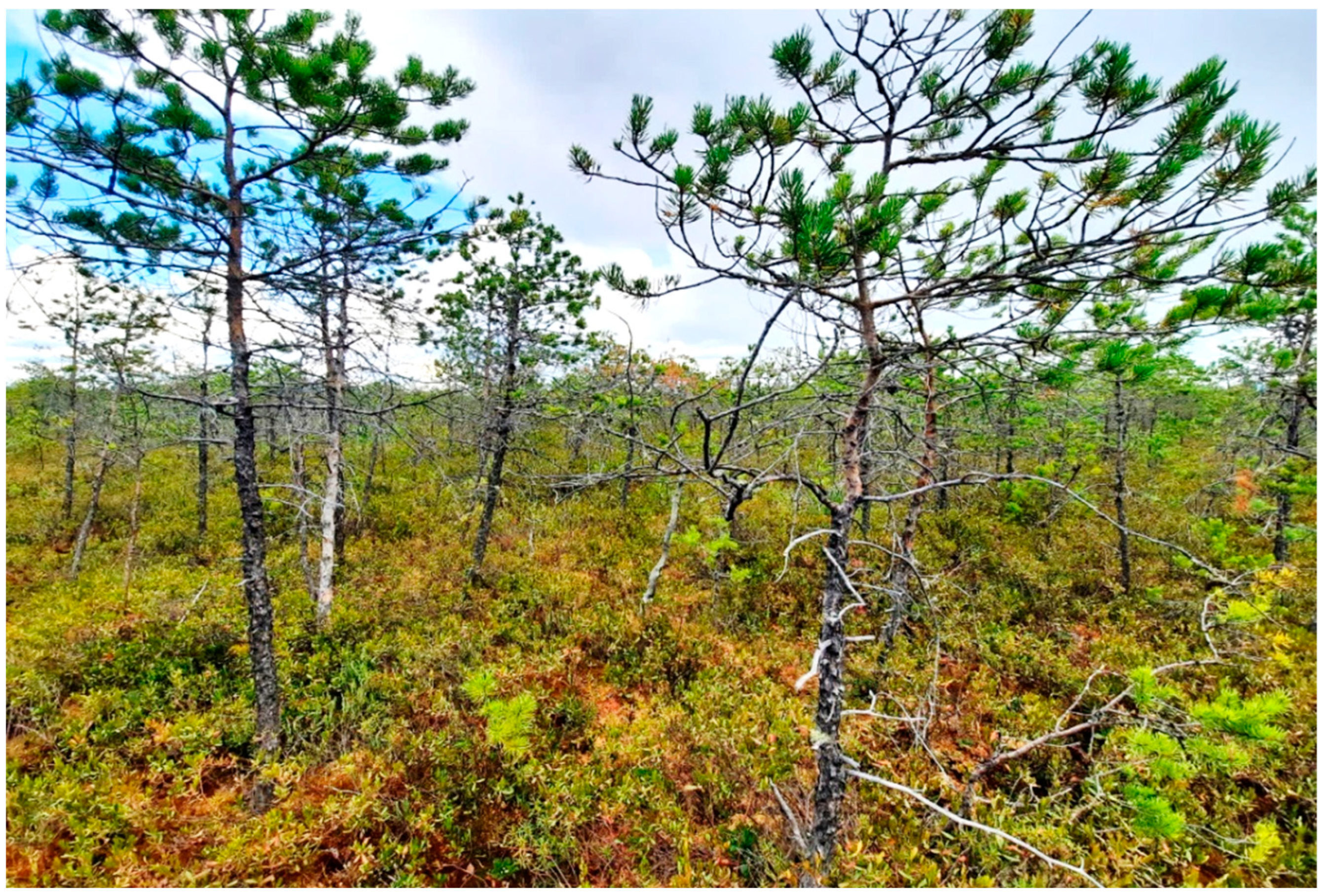


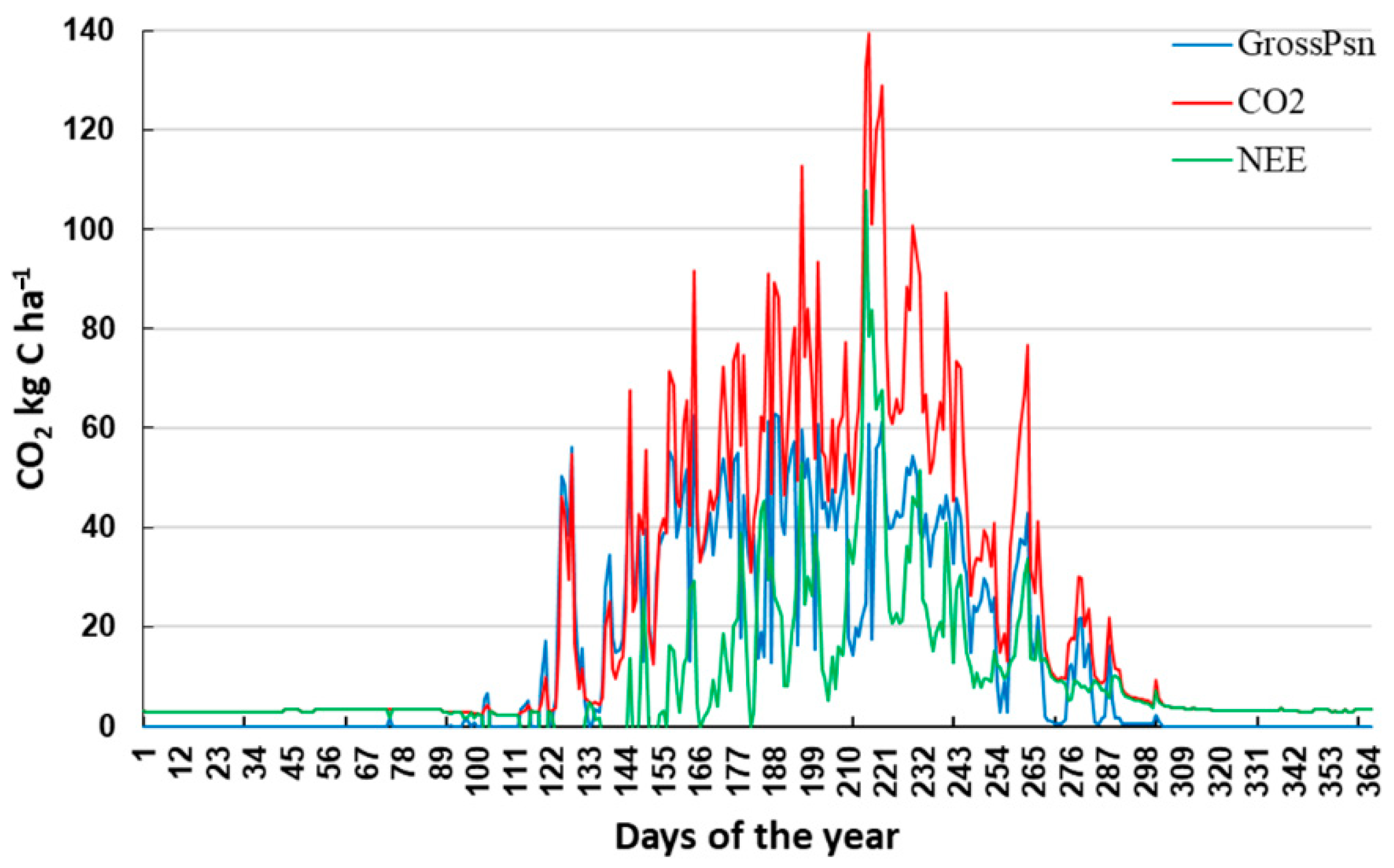
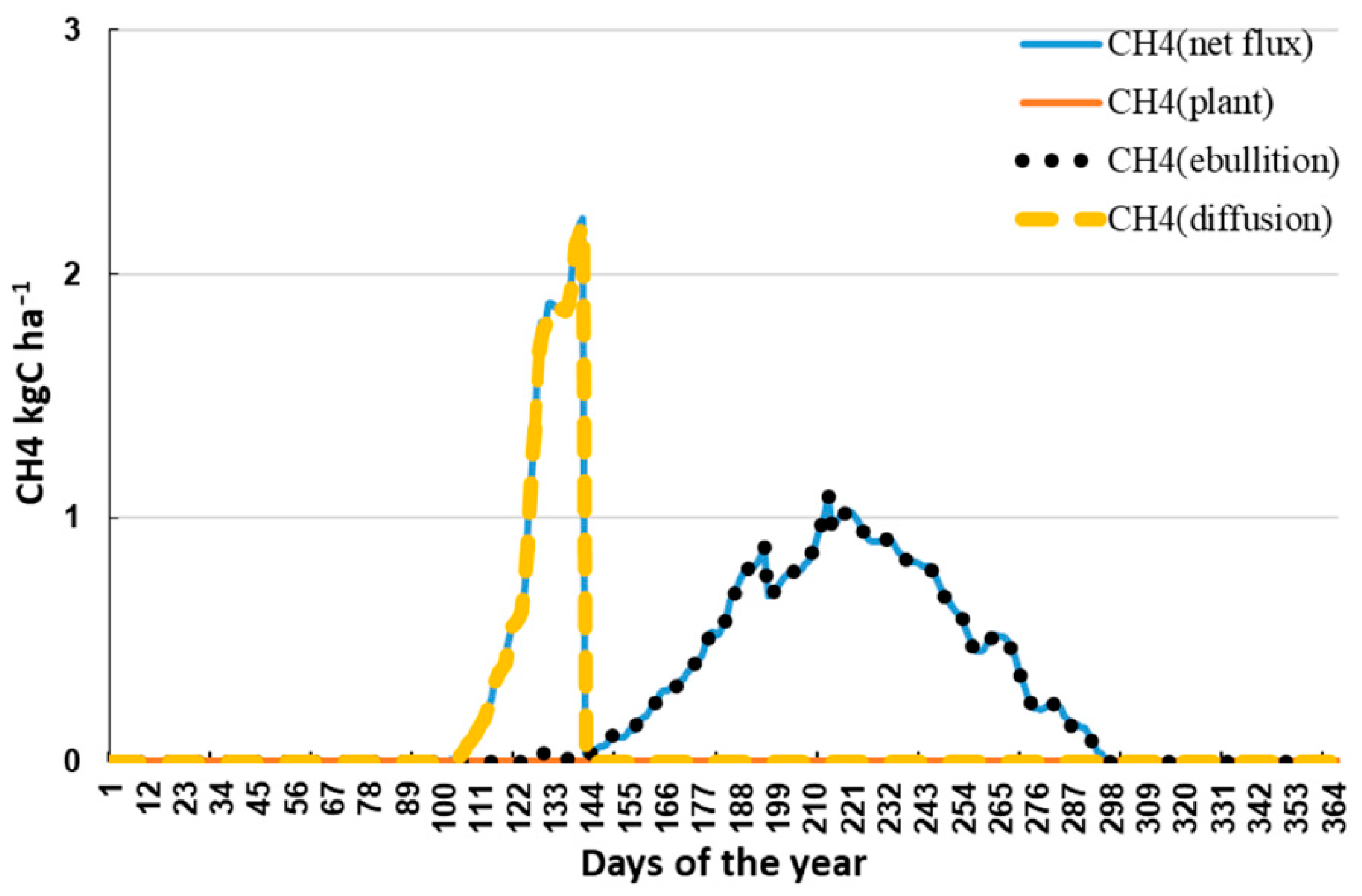
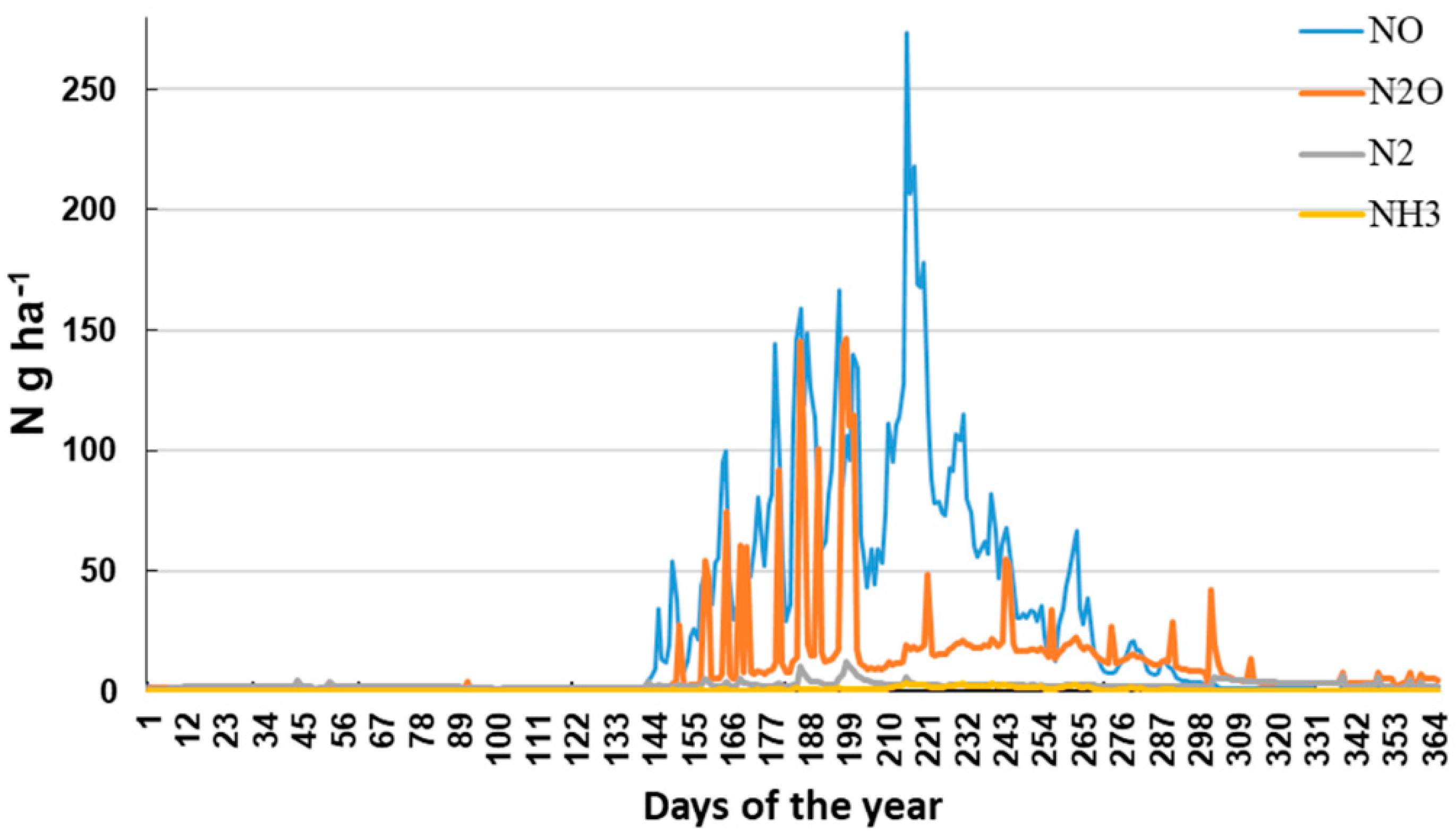

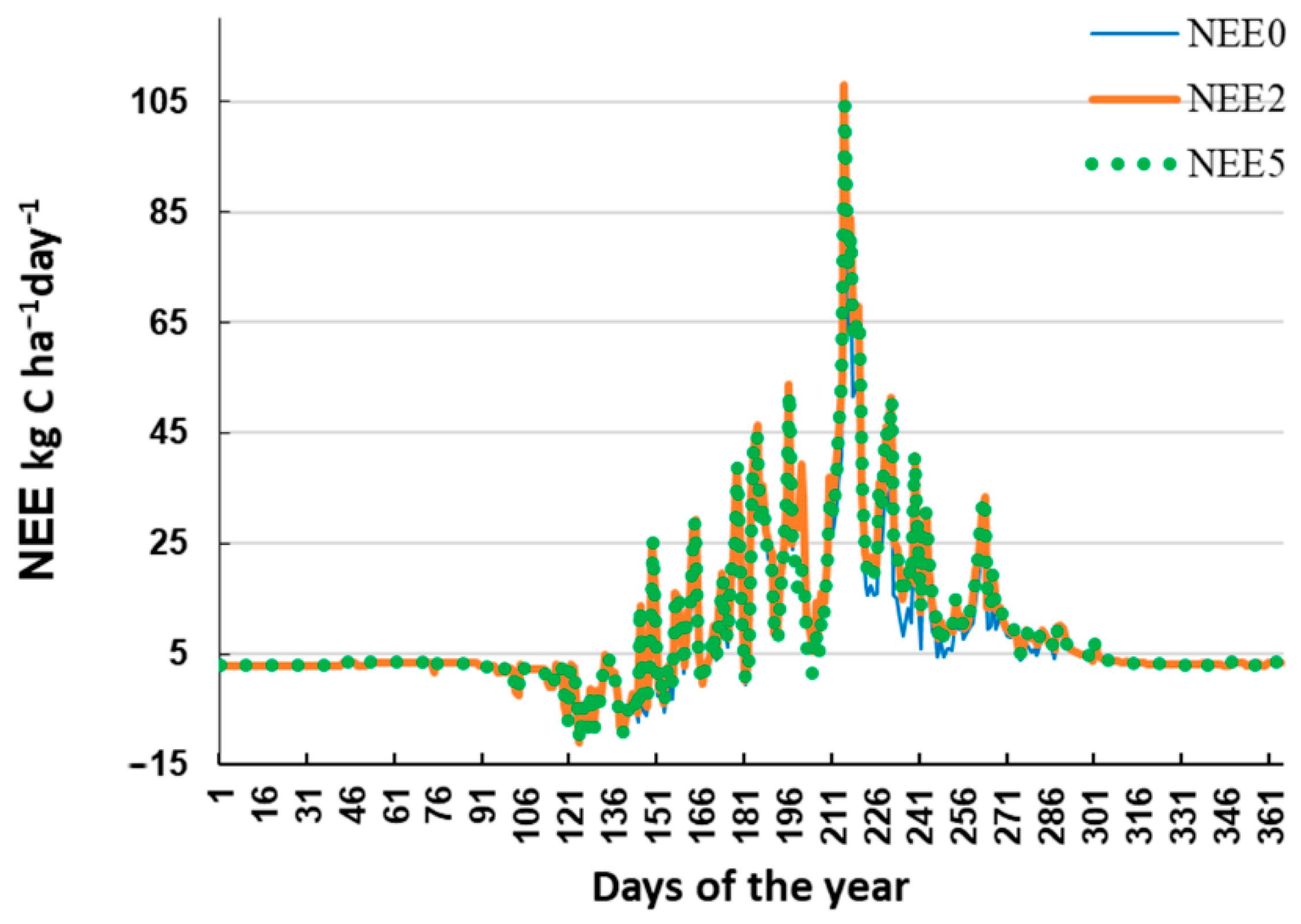
| Parameter | Parameter Values | R2 | Σ NEE | Σ CH4 |
|---|---|---|---|---|
| 1 | 2 | 0.60 | 2425 | 258 | |
| 0.75 | 2.25 | 0.67 | 2452 | 202 | |
| Thickness | 0.5 | 2.5 | 0.67 | 2502 | 119 |
| 0.3 | 2.7 | 0.64 | 1663 | 46.5 | |
| 0.1 | 2.9 | 0.59 | 113 | 40.0 | |
| 0.4 | 0.67 | 2476 | 117 | |
| 0.95 | 0.67 | 2476 | 117 | |
| Hydrological conductivity | 1.5 | 0.67 | 2476 | 117 |
| 2.05 | 0.67 | 2476 | 117 | |
| 2.6 | 0.67 | 2477 | 117 | |
| 0.46 | 0.66 | 1521 | 118 | |
| 0.58 | 0.66 | 2127 | 118 | |
| Porosity | 0.69 | 0.67 | 2502 | 119 |
| 0.81 | 0.67 | 2244 | 116 | |
| 0.92 | 0.67 | 2749 | 117 | |
| 0.2 | 0.67 | 2749 | 117 | |
| Wilting point | 0.45 | 0.67 | 2749 | 117 |
| 0.7 | 0.67 | 2749 | 117 | |
| 4 | 30 | 0.67 | 2749.4 | 117 | |
| Layers | 2 | 15 | 0.65 | 1881 | 46.7 |
| 1 | 15 | 0.58 | 81.2 | 40.6 |
| Parameter | Parameter Values | T | R2 | Σ NEE | Σ CH4 |
|---|---|---|---|---|---|
| 0.4 | 0.11 | −0.16 | 2375 | 408 | |
| 0.2 | 0.11 | −0.10 | 2389 | 408 | |
| 0.1 | 0.10 | 0.00 | 2415 | 408 | |
| 0.05 | 0.09 | 0.18 | 2459 | 408 | |
| Alpha | 0.02 | 0.08 | 0.50 | 2562 | 408 |
| 0.01 | 0.07 | 0.63 | 2683 | 408 | |
| 0.005 | 0.11 | 0.22 | 2837 | 408 | |
| 0.001 | 0.34 | −4.09 | 3206 | 408 | |
| 17.2 | 0.38 | −28.0 | 1414 | 408 | |
| 12 | 0.28 | −10.3 | 1874 | 408 | |
| 9 | 0.19 | −3.16 | 2186 | 408 | |
| 6 | 0.08 | 0.44 | 2543 | 408 | |
| Max Psn | 5.85 | 0.08 | 0.50 | 2562 | 408 |
| 5.5 | 0.07 | 0.59 | 2608 | 408 | |
| 5.0 | 0.07 | 0.59 | 2674 | 408 | |
| 3 | 0.19 | −1.11 | 2959 | 408 | |
| 1 | 0.42 | −6.13 | 3282 | 408 |
| Wetlands | Coefficient of Determination |
|---|---|
| Wetlands in North America [37] | R2 = 0.52 at N = 468 for groundwater level; |
| R2 = 0.91 at N = 59 for soil temperature; | |
| R2 = 0.76 at N = 214 for CH4 fluxes; | |
| R2 = 0.49 at N = 266 for NEE ecosystem net productivity | |
| Wetlands in Florida [65] | R2 = 0.71 for groundwater level; |
| R2 = 0.62 for CH4 fluxes; | |
| R2 = 0.75 for NEE | |
| Peat bog in Canada [66] | R2 = 0.79–0.86 for GPP |
| R2 = 0.86–0.87 for ecosystem respiration | |
| Wetlands in northeastern and southwestern China, Canada and the USA [67] | R2 = 0.84 for CH4 fluxes |
| Alpine wetlands in Qinghai–Tibet Plateau [68,69] | R2 = 0.89 for soil temperature; |
| R2 = 0.86 for ecosystem respiration; | |
| R2 = 0.81 for gross primary GPP; | |
| R2 = 0.52 for NEE ecosystem net productivity | |
| Forest watershed (160 ha) in South Carolina, USA, [70] | R2 = 0.66–0.88, for groundwater level; |
| R2 = 0.83 for soil temperature; | |
| R2 = 0.66 and E = 0.61 for soil CO2 flux |
Publisher’s Note: MDPI stays neutral with regard to jurisdictional claims in published maps and institutional affiliations. |
© 2022 by the authors. Licensee MDPI, Basel, Switzerland. This article is an open access article distributed under the terms and conditions of the Creative Commons Attribution (CC BY) license (https://creativecommons.org/licenses/by/4.0/).
Share and Cite
Mikhalchuk, A.; Borilo, L.; Burnashova, E.; Kharanzhevskaya, Y.; Akerman, E.; Chistyakova, N.; Kirpotin, S.N.; Pokrovsky, O.S.; Vorobyev, S. Assessment of Greenhouse Gas Emissions into the Atmosphere from the Northern Peatlands Using the Wetland-DNDC Simulation Model: A Case Study of the Great Vasyugan Mire, Western Siberia. Atmosphere 2022, 13, 2053. https://doi.org/10.3390/atmos13122053
Mikhalchuk A, Borilo L, Burnashova E, Kharanzhevskaya Y, Akerman E, Chistyakova N, Kirpotin SN, Pokrovsky OS, Vorobyev S. Assessment of Greenhouse Gas Emissions into the Atmosphere from the Northern Peatlands Using the Wetland-DNDC Simulation Model: A Case Study of the Great Vasyugan Mire, Western Siberia. Atmosphere. 2022; 13(12):2053. https://doi.org/10.3390/atmos13122053
Chicago/Turabian StyleMikhalchuk, Alexander, Ludmila Borilo, Elena Burnashova, Yulia Kharanzhevskaya, Ekaterina Akerman, Natalia Chistyakova, Sergey N. Kirpotin, Oleg S. Pokrovsky, and Sergey Vorobyev. 2022. "Assessment of Greenhouse Gas Emissions into the Atmosphere from the Northern Peatlands Using the Wetland-DNDC Simulation Model: A Case Study of the Great Vasyugan Mire, Western Siberia" Atmosphere 13, no. 12: 2053. https://doi.org/10.3390/atmos13122053






